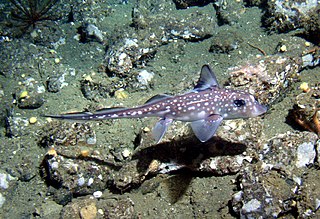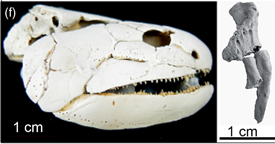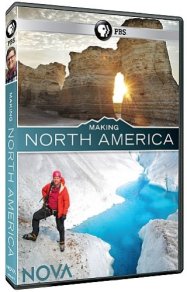
Ketchikan is a city in and the borough seat of the Ketchikan Gateway Borough of Alaska. It is the state's southeasternmost major settlement. Downtown Ketchikan is a National Historic District.

The Desmostylia are an extinct order of aquatic mammals that existed from the early Oligocene (Rupelian) to the late Miocene (Tortonian).

Chimaeras are cartilaginous fish in the order Chimaeriformes, known informally as ghost sharks, rat fish, spookfish, or rabbit fish; the last three names are not to be confused with rattails, Opisthoproctidae, or Siganidae, respectively.

Helicoprion is an extinct genus of shark-like eugeneodont fish. Almost all fossil specimens are of spirally arranged clusters of the individuals' teeth, called "tooth whorls", which in life were embedded in the lower jaw. As with most extinct cartilaginous fish, the skeleton is mostly unknown. Fossils of Helicoprion are known from a 20 million year timespan during the Permian period from the Artinskian stage of the Cisuralian to the Roadian stage of the Guadalupian. The closest living relatives of Helicoprion are the chimaeras, though their relationship is very distant. The unusual tooth arrangement is thought to have been an adaption for feeding on soft bodied prey, and may have functioned as a deshelling mechanism for hard bodied cephalopods such as nautiloids and ammonoids. In 2013, systematic revision of Helicoprion via morphometric analysis of the tooth whorls found only H. davisii, H. bessonowi and H. ergassaminon to be valid, with some of the larger tooth whorls being outliers.

The spotted ratfish is a chimaera found in the north-eastern Pacific Ocean. Often seen by divers at night in the Pacific Northwest, this cartilaginous fish gets its characteristic name from a pointed rat-like tail. The ratfish lays leathery egg cases on the bottom of muddy or sandy areas, which are often mistaken by divers as something inanimate. While mainly a deep-water species, it occurs at shallower depths in the northern part of its range. The generic name, Hydrolagus, comes from the Greek words ὕδωρ, meaning water, and λαγώς/λαγῶς, meaning hare, and the specific name honors Alexander Collie, who was a ship surgeon and early naturalist. The spotted ratfish is common in much of its range, not typically eaten by humans, and is not commercially caught.

Gogonasus was a lobe-finned fish known from three-dimensionally preserved 380-million-year-old fossils found from the Gogo Formation in Western Australia. It lived in the Late Devonian period, on what was once a 1,400-kilometre coral reef off the Kimberley coast surrounding the north-west of Australia. Gogonasus was a small fish reaching 30–40 cm (1 ft) in length.

The pointy-nosed blue chimaera, also known as the pointy-nosed blue ratfish, Ray Troll's chimaera or abyssal ghostshark, is a species of deep-sea fish in the family Chimaeridae.

The Stonerose Interpretive center & Eocene Fossil Site is a 501c(3) non-profit public museum and fossil dig located in Republic, Washington. The center was established in 1989 and houses fossils that have been featured in National Geographic Magazine, Sunset magazine, and numerous scientific works.

Delores E. Churchill is a Native American artist of Haida descent. She is a weaver of baskets, hats, robes, and other regalia, as well as leading revitalization efforts for Haida, her native language.

Parahelicoprion is an extinct genus of shark-like eugeneodontid holocephalids from the Permian of the Ural Mountains (Russia) and Copacabana Formation, Bolivia. The genus name, from "nearly coiled saw" in Greek, directly refers to Helicoprion, a related holocephalid that shares similar traits to it, including the helical whorl of teeth.
Mesoclupea showchangensis is an extinct ichthyodectiform ray-finned fish that lived in freshwater environments in what is now China during the Early Cretaceous epoch. It differs from its sister genus, Chuhsiungichthys, primarily by having a more posteriorly-placed dorsal fin.

Joan Naviyuk Kane is an Inupiaq American poet. In 2014, Kane was the Indigenous Writer-in-Residence at the School for Advanced Research. She was also a judge for the 2017 Griffin Poetry Prize. Kane was awarded a Guggenheim Fellowship in 2018.

Nathan Jackson is an Alaska Native artist. He is among the most important living Tlingit artists and the most important Alaskan artists. He is best known for his totem poles, but works in a variety of media.

Wesley Conrad Wehr was an American paleontologist and artist best known for his studies of Cenozoic fossil floras in western North America, the Stonerose Interpretive Center, and as a part of the Northwest School of art. Wehr published two books with University of Washington Press that chronicled his friendships with artists and scientists.

Fins are distinctive anatomical features composed of bony spines or rays protruding from the body of Actinopterygii and Chondrichthyes fishes. They are covered with skin and joined together either in a webbed fashion, as seen in most bony fish, or similar to a flipper, as seen in sharks. Apart from the tail or caudal fin, fish fins have no direct connection with the spine and are supported only by muscles. Their principal function is to help the fish swim.

Kirk R. Johnson is an American paleontologist, author, curator, and museum administrator, and is currently serving as Sant Director of Smithsonian's National Museum of Natural History.

Making North America is a 2015 American documentary film which premiered nationwide on November 4, 2015. The PBS Nova film, comprising three episodes of one hour each, was hosted by Kirk Johnson ; Peter Oxley directed the first episode while Gwyn Williams directed the second and third. The series describes the very beginnings and later developments of the North American continent: from the origin of planet Earth 4.54 billion years ago; to the various movements of tectonic plates and their effect on the sculpturing of the continent's land and mountains, including the Rocky Mountains, Yellowstone and the Grand Canyon; to the emergence of life on the continent and its later evolution; and, finally, to the more recent settlement of the land by humans. According to Johnson, "Most people will not have considered a time when there was no North America ... What was there before North America? How did it form? When did it start? How did it come together?"

Teri Rofkar, or Chas' Koowu Tla'a (1956–2016), was a Tlingit weaver and educator from Sitka, Alaska. She specialized in Ravenstail designs and spruce root baskets.

Roger Lansing Grande, more commonly known as Lance Grande, is an evolutionary biologist and curatorial scientist. His research and work is focused on Paleontology, Ichthyology, Systematics and Evolution. He is best known for his work on the paleontology of the Green River Formation and for his detailed monographs on the comparative anatomy and evolution of ray-finned fishes.
Terry Pyles is an Alaskan artist whose work includes depictions of the sights and scenery in the state. He makes sculptures and paints.

















